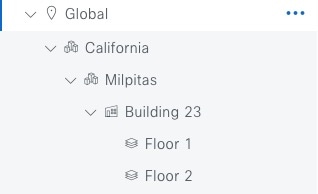Network hierarchy overview
You can create a network hierarchy that represents the geographical locations of your network.
Structure of a network hierarchy
The network hierarchy is organized in a hierarchical structure. This hierarchy consists of sites. A site may refer to an area, building, or floor. The placement of each site in the hierarchical structure depends on network hierarchy rules. See this figure and table to learn how you can structure different sites in your network hierarchy.

|
Site types |
Description |
Rule |
||
|---|---|---|---|---|
|
Global ( |
The default site element under which all other site elements reside. |
Only areas and buildings can reside directly under Global. |
||
|
Areas ( |
Areas identify a geographic region. They provide a way to group areas, buildings, or both areas or buildings. Therefore, they do not have a physical address. |
Areas can reside directly under Global or other areas. |
||
|
Buildings ( |
Buildings can have physical addresses or latitude and longitude coordinates. |
Buildings can reside directly under Global or areas. They cannot contain areas, but they can contain floors. |
||
|
Floors ( |
Floors can be added to buildings with or without maps that contain various building components, like walls and windows. Floor maps allow you to visualize the wireless network coverage of your wireless devices positioning on the floor. You can manually create them or import them from files, such as DXF, DWG, JPG, GIF, PNG, or PDF file types. |
Only floors reside under buildings.
|
Apply design settings to a site
The hierarchical organization of the network hierarchy allows you to easily apply design settings or configurations to a specific hierarchical site. For example, you can apply design settings to an entire area or to only a floor.
 Tip |
Naming hierarchical sites can help you identify where to apply design settings later. |
Build your network hierarchy
To get started, build your network hierarchy using one of these methods:
-
Create the network hierarchy. For more information, see Create the network hierarchy.
-
Import an existing network hierarchy from Cisco Prime Infrastructure or Ekahau Pro. For more information, see Use an existing Cisco network hierarchy or Use an existing Ekahau network hierarchy.
 )
)
 )
)
 )
)

 next to the desired site, building, or floor and select
next to the desired site, building, or floor and select 
 Feedback
Feedback